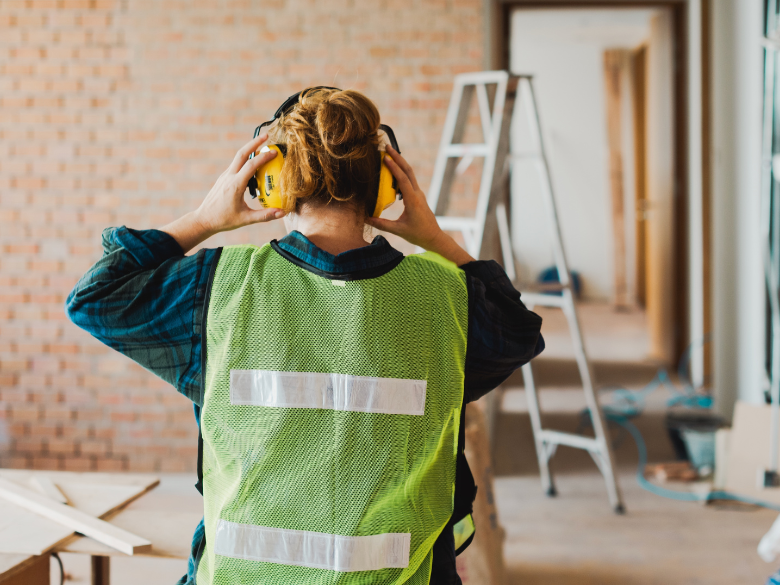Protecting your hearing on-site and beyond
Sep 22, 2025

Every year in September, people around the world mark Global Deaf Awareness Week (22–28 September 2025). It’s a chance to recognise the importance of communication, accessibility, and inclusion for the Deaf community. For those of us working in construction, it’s also the perfect reminder of how precious our hearing is, and how easily it can be damaged by the noise we’re exposed to every day.
Noise: The silent risk on-site
Power tools, heavy machinery, vehicles, and hammering – the soundtrack of a busy site is loud. And while it might just feel like “part of the job,” that constant exposure can take a serious toll on your hearing over time.
Noise-induced hearing loss (NIHL) happens when loud sounds damage the sensitive structures in your inner ear. Depending on the type and extent of damage, NIHL can be temporary or permanent. The good news? Unlike many other forms of hearing loss, NIHL is entirely preventable.
It’s also very common. According to Safe Work Australia about 28–32% of Australian workers are exposed to loud noise at work. People who work in noisy industries, like construction, agriculture, carpentry, mining, oil and gas, and the military, are especially at risk.
How loud is too loud?
You might be surprised at just how quickly noise becomes dangerous. Here are some benchmarks:
- 85 decibels (dB): About as loud as heavy traffic. Safe for around 8 hours.
- 100 dB: A chainsaw or jackhammer. Damage can occur after just 15 minutes.
- 110 dB+: A nail gun or rock concert. Even a few minutes without protection can cause permanent damage.
On a construction site, these levels are reached every day, sometimes without us even realising.
Symptoms of Noise-Induced Hearing Loss
Hearing loss doesn’t usually happen all at once. Symptoms can creep up slowly, which is why many people don’t notice until it’s too late. Some of the most common signs of NIHL include:
- A feeling of fullness or pressure in your ear.
- Inability to hear high-pitched sounds, like birds singing.
- Muffled or distorted speech, making conversations harder to follow.
- Tinnitus – ringing, buzzing, or roaring in the ears.
There are two main types of NIHL:
- Acoustic trauma: Instant hearing loss from one very loud, forceful and sudden sound (like a gunshot or firecracker). This damage is often permanent.
- Chronic NIHL: Gradual hearing loss from repeated exposure to loud sounds over time (like noisy worksites or even loud headphones). It can take weeks, months, or years before you notice the problem.
Beyond the job: The personal impact of hearing loss
Hearing loss doesn’t just affect you at work. It changes your whole life.
- Conversations become harder. Background noise makes it tough to follow what’s being said.
- Social situations can feel isolating. It’s easier to avoid gatherings than struggle to keep up.
- Confidence takes a hit. Many people with hearing loss feel self-conscious about asking others to repeat themselves.
- Relationships are impacted. Miscommunication and frustration can creep in with family and friends.
And the effects don’t stop there. Untreated NIHL has been linked to:
- Anxiety and depression.
- Fatigue and insomnia from straining to hear.
- High blood pressure, increased heart rate, and stress.
- Irritability and hyperacusis (heightened sensitivity to sound).
In short, it doesn’t just change what you can hear, it changes how you live, connect, and feel day to day.
Protecting your ears on-site
The good news is, hearing loss from noise exposure is 100% preventable. Here’s how:
- Wear the right protection: Use earplugs or earmuffs that are rated for the noise level you’re working in.
- Use quieter equipment when possible: Look for low-noise models or maintain tools well to reduce noise output.
- Create quiet zones: Step away from noisy work regularly to give your ears a break.
- Check the levels: Ask a competent person to come in and complete a detailed noise assessment.
- Check out our blog here for more ways to manage noise on-site
What to do if you’re concerned about your hearing
If you think you might already be experiencing signs of NIHL, don’t ignore it. Talk to your primary care physician or healthcare provider – they can refer you to an audiologist (hearing specialist) or otolaryngologist (ear, nose, and throat doctor) for further tests.
Specialists use a range of hearing assessments to diagnose NIHL and check if there are any other contributing factors. Getting tested early is important: even if hearing loss can’t be reversed, the right support and treatment can help you manage symptoms, protect the hearing you have left, and improve your quality of life.
Take action this September
This week, let’s not just raise awareness, let’s take action. Protect your hearing, look out for your team, and start conversations about noise on-site.
Because hearing isn’t just about safety at work. It’s about being able to connect, laugh, share stories, and enjoy life for years to come.









